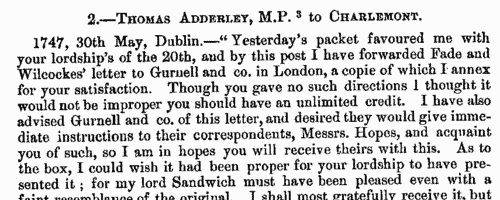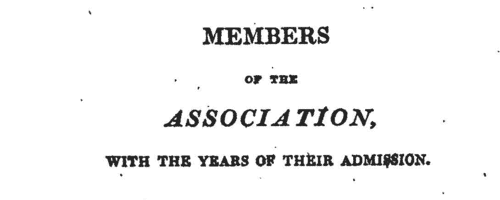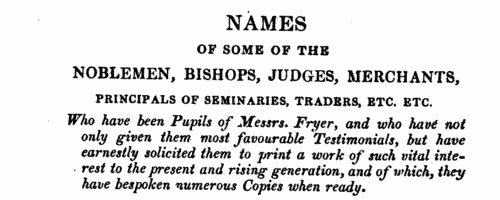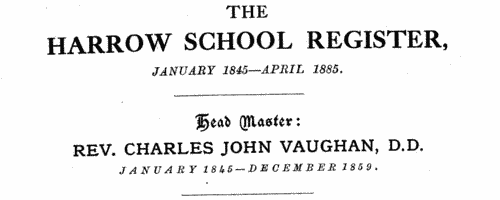Hoops Surname Ancestry ResultsOur indexes 1000-1900 include entries for the spelling 'hoops'. In the period you have requested, we have the following 13 records (displaying 1 to 10): Buy all | | | Get all 13 records to view, to save and print for £68.00 |
These sample scans are from the original record. You will get scans of the full pages or articles where the surname you searched for has been found. Your web browser may prevent the sample windows from opening; in this case please change your browser settings to allow pop-up windows from this site.  Apprentices
(1757) Apprentices
(1757)
Apprenticeship indentures and clerks' articles were subject to a 6d or 12d per pound stamp duty: the registers of the payments usually give the master's trade, address, and occupation, and the apprentice's name, as well as details of the date and length of the apprenticeship. 1 January to 31 December 1757.HOOPS. Cost: £8.00.  | Sample scan, click to enlarge

| Memoirs and correspondence of the 1st Earl of Charlemont
(1745-1783)
James Caulfeild, first Earl of Charlemont, worked for the emancipation of Ireland from the control of the parliament of England, and was commander-in-chief of the Ulster Volunteers. Here are his political memoirs, a calendar of his correspondence, and copies of many letters in full.HOOPS. Cost: £4.00.  | Sample scan, click to enlarge

| Irish Clergy and Gentlemen Discountenancing Vice
(1822)
The Association Incorporated for Discountenancing Vice and Promoting the Knowledge and Practice of the Christian Religion had an extensive membership in Ireland, of which this list was published as the 13th appendix to a Sermon preached before the members and their president, the Lord Lieutenant, in St Peter's church by Charles R. Elrington, D. D., his chaplain. The list gives each member's full name, surname first, with the year of admission to the society. This index also covers the fourteenth appendix, listing the members' subscriptions received in 1821, but some for previous years' arrears as far back as 1817, and whether paid in diocesan committees or in Dublin. Most of the members were gentlemen or clergy.HOOPS. Cost: £6.00.  | Sample scan, click to enlarge

| Irish Insolvents
(1837)
Insolvency notices for Ireland: insolvency often caused people to restart their lives elsewhere, so these are an important source for lost links, especially for emigrantsHOOPS. Cost: £6.00.  | Sample scan, click to enlarge

| Subscribers to Willcolkes and Fryers' Arithmetic: Ireland
(1843)
'The United New and Much Admired System of Arithmetic and Mental Calculations, of Doctor Willcolkes and Messrs. T. and T. W. Fryer; Being the Result of Many Years’ Study. Eighth Edition, Much Enlarged and Carefully Revised' was published in 1843 in Derby. The list of subscribers includes sections for Ashton, Beverley, Boston, Dewsbury, Doncaster, Grantham, Halifax, Heckmondwike, Huddersfield, Hull, Ireland, Leeds, Lincoln, Liverpool, Manchester, Newark, Oldham, Rochdale, Rotherham, Sheffield, Stalybridge, Stamford, Stockport, Wakefield, Warrington, as well as separate lists of bankers and principals of seminaries. More precise addresses are rarely given, christian names hardly ever.
HOOPS. Cost: £4.00.  | Sample scan, click to enlarge

| Deaths, Marriages, News and Promotions
(1847)
Death notices and obituaries, marriage and birth notices, civil and military promotions, clerical preferments and domestic occurrences, as reported in the Gentleman's Magazine. Mostly from England and Wales, but items from Ireland, Scotland and abroad. July to December 1847
HOOPS. Cost: £4.00.  | Sample scan, click to enlarge

|  Naval support staff in the Crimean War
(1854-1856) Naval support staff in the Crimean War
(1854-1856)
Sebastopol in the Crimea was the great Russian naval arsenal on the Black Sea. A combined assault by British, French and Turkish troops resulted in the reduction of Sebastopol and led to the Treaty of Paris of 27 April 1856, guaranteeing the independence of the Ottoman Empire. By Admiralty Order the Crimea Medal was awarded to sailors and marines present during the campaign, between 17 September 1854 (the first landing at Eupatoria) and 9 September 1855 (when the allies secured Sebastopol). Four clasps to this medal were awarded to the men present in the actions at Sebastopol itself, Inkerman, Balaklave (Balaclava) and (the sea of) Azoff, but the recipients of these clasps are recorded on separate rolls, not part of this index, but indexed on this site.HOOPS. Cost: £8.00.  | Sample scan, click to enlarge

|  Persons of standing recommending London police recruits
(1843-1857) Persons of standing recommending London police recruits
(1843-1857)
The Metropolitan Police Register of Joiners (MEPO 4/334) lists policemen joining the force 1 January 1843 to 1 April 1857 (warrant numbers 19893 to 35804). The register is alphabetical, in so far as the recruits are listed chronologically grouped under first letter of surname. It gives Date of Appointment, Name, Number of Warrant, Cause of Removal from Force (resigned, dismissed, promoted or died), and Date of Removal. Although the register was closed for new entrants at the end of 1842, the details of removals were always recorded, some being twenty or more years later. Those recruits not formerly in the police, the army, or some government department, were required to provide (normally) at least two letters of recommendation from persons of standing, and details of these are entered on the facing pages. Where a recruit was only recently arrived in the metropolis, the names and addresses of the recommenders can be invaluable for tracing where he came from. Those recruits not formerly in the police, the army, or some government department, were required to provide (normally) at least two letters of recommendation from persons of standing, and details of these are entered on the facing pages: the names in these are indexed here (the police recruits are indexed separately and not included here). Recruits transferred from other forces or rejoining the force did not normally need recommendations - in the latter case, former warrant numbers are given - but some recommendations are from police inspectors, even other constables. Recruits coming from the army sometimes have general military certificates of good conduct, but most often have a letter from their former commanding officer; recruits recommended by government departments (most often the Home Office) similarly have letters from the head of department. But the great majority of the names and addresses in these pages are of respectable citizens having some sort of personal acquaintance with the recruit. Where more than two recommendations were provided, the clerk would only record one or two, with the words 'and others'. Tradesmen are sometimes identified as such by their occupations; there are some gentry. Although the bulk of these names are from London and the home counties, a scattering are from further afield throughout Britain and Ireland. HOOPS. Cost: £8.00.  | Sample scan, click to enlarge

| Boys entering Harrow School
(1866)
This First Volume of the Second Series of the Harrow School Register was edited by J. H. Stogdon and published in 1925. The boys are listed by term of entrance, and then alphabetically by surname and christian names (in bold). Next, in brackets and in italics, is the school house to which he belonged - or, H. B. indicating a day boy whose family lived in Harrow. Stogdon then gives the father's surname and initials, and address. In cases where the boy was prominent in sports at school, or won academic prizes, scholarships &c., that is given; then the year of leaving the school; and a synopsis of his career, so far as known.
HOOPS. Cost: £4.00.  | Sample scan, click to enlarge

| Freeholders in county Sligo
(1873-1875)
Owners of an acre or more, whether resident there or elsewhere: with their addresses; the acreage; and a valuation of the land. The survey commenced in February 1873, the last returns being received in November 1875.HOOPS. Cost: £4.00.  | Sample scan, click to enlarge

|
| 1 | 2 |  |
Research your ancestry, family history, genealogy and one-name study by direct access to original records and archives indexed by surname.
|













